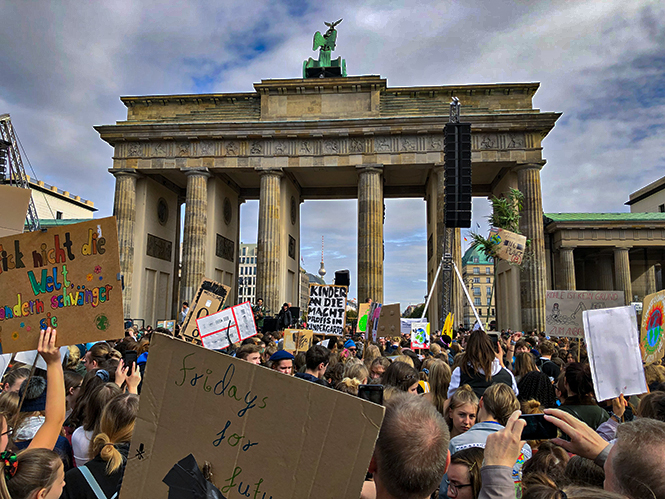
Former Spartan Aidan Maloof captured the strike in Berlin, Germany. photo by Aidan Maloof
Millions of advocates left work, school, and their homes and flooded the streets in order to raise awareness to combat the current climate crisis.
From September 20-27th, a record-breaking 7.6 million people took their passion to the streets to participate in the Global Climate Strike as their call to action against climate change. Occurring in 185 different countries, this protest was a major historical landmark in the movement for a better future. Due to an increase in carbon dioxide and other major emissions in the past century, the global temperature is rising at an alarming rate. The oceans’ water temperature is on the rise as well, causing ice sheets to melt and glaciers to retreat. The global sea level has risen eight inches, posing a major threat to coastal residents. Intense weather events have been increasing exponentially, including torrential downfalls of rain and hail, tornadoes, hurricanes, and more. A myriad of events have infused fear and panic into society, and change is being demanded.
Due to mass communication through social media, people are becoming increasingly more aware of the severity of the climate situation, and many agree that it’s time to take action. Greta Thunberg, a 16-year-old environmental advocate from Sweden, initiated the Global Climate Strike. She traveled the world protesting climate change, one city at a time. Individuals with all different backgrounds, ages, genders, and ethnicities came together as one enormous call to action. The demand for change is directed towards governments who aren’t limiting how much carbon corporations are able to emit into the atmosphere or how much waste they are allowed to produce. The demand is directed towards corporations who are refusing to change their policies, due to an economic perspective that has altered society. The demand is directed towards the people who are unaware as to how their actions affect every single species trying to survive on this planet.
The fate of humanity is constantly being rewritten, the time frame exponentially decreasing. Maddi Abram, 2019 TJ graduate, who participated in the climate strike in Boulder, shares: “As a teenager, it can be quite scary to hear about all these dangers and not know what the future may hold for us. It is quite terrifying to confront the possibility that we may not be able to live the lives we have always thought we would be able to.” As teenagers in a changing world, it seems outrageous to not want to protect the future. However, most of the power is in the hands of the older generations, the majority of whom do not understand the very real fear that teens possess.
As one of the largest coordinated global protests in history, the climate strike brought a vast amount of attention to the issue at hand. If the climate strike succeeds, businesses and governments will begin to make changes for a more sustainable future. However, due to how recent the strike was, and the ongoing fight, the overarching results are still unknown. Former TJ student Aidan Maloof participated in the strike in Germany. “I think that we’re gonna see some change soon. People have been talking about climate change for years and how scary it’s going to be, but now we’re starting to see the symptoms of a warming planet. As more and more people start being directly impacted by climate change, we’ll see it become a larger issue.” The time to act was decades ago, long before any scientific data was released. However, it’s important to note that it’s not too late to make a difference. Maloof adds, “This protest is a sign of progress, because many people have been doing their part as individuals, but it’s time for us to all come together and hold our governments accountable. There’s only so much one can do as an individual and it’s time to act on a greater scale.”
It’s important to remember that there is still time to get involved. Senior Phoebe Briney, president of TJ’s Sustainability Club, encouraging students to bike to school, and raising awareness for the issues at hand. Briney states, “There’s still possibility for change, but the strike isn’t going to do it all. We have to keep working and influencing the lawmakers to make change, along with doing things ourselves, but we are taking a step in the right direction.” The media coverage of the climate crisis is meant to seem scary and pressing, as that is what motivates society to act fast. Abram remarked, “In spite of this fear, it is really amazing to see so many young people in our generation come together. It gives me hope that we will be able to make significant strides in the near future.”